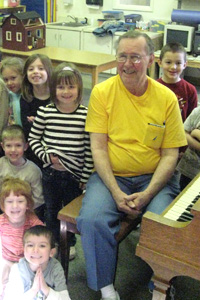 |
| Aaron with Grandma Grace in Ireland, outside of Kylemore Abbey in the city of Galway |
EDITOR'S NOTE: Generations United shared an Oct. 24 Washington Post article through Facebook on millennials being caregivers to their elders. According to the article, one in four family caregivers is now 18-34. After reading this article, Aaron Larsen was moved to recount the value of his grandparents. Here's his story.
This guest post and photos appear courtesy of Aaron Larsen, a digital marketing consultant and creator of GrandparentsAcademy.com.
At first, I felt like a complete and utter failure. I felt like I did everything right - got the grades, excelled in extra curriculars, etc.
I did everything my wonderful teachers, counselors and society told me to do in order to get that great job out of college, but it simply wasn't in the cards.
Because of that, I was in a bit of a dark place after graduating. I was lost.
 |
| (PHOTO: Bill Wilhelm) Aaron with Grandma Grace, during her surprise
birthday celebration at a pub in Dublin, Ireland. |
Living with Grandma Grace at that time in my life was the blessing I needed. I taught her Facebook and she taught me the true value of family and faith.
The next year, I decided to live with my Granny and Grandpa Grit.
Grandpa Grit had suffered from a debilitating stroke that compromised his speech and mobility of half his body.
Granny Grit was caring for him on her 4.5 acres of hillside country property (which included horses, dogs and a barn kitty), and was holding down a part-time job.
Being there for Grandpa during his last year of his life was one of the toughest yet rewarding experiences.
I learned a lot about what true grit and courage is. Most of all, I realized our time here is limited.
We must use it wisely. We must learn how to grow ourselves and others with love.
We must use it wisely. We must learn how to grow ourselves and others with love.
Living with my grandparents in my 20's wasn't something I envisioned happening. It certainly wasn't mentioned in my high school valedictorian speech.
But I believe I learned more from the "Grand School" years than I would have ever learned in Grad School.
And even though it was unexpected and uncomfortable at times, the harvest was nothing short of divine.
If younger generations have anything close to the experience I had, while living with and caring for grandparents, I have no doubt our society will be better for it.
So please, next time you hear a critical word about the younger generation, please consider that maybe we aren't failing to launch by returning home to our parents or grandparents.
Instead, we're returning to the garden to nurture the seeds that will grow the values in which our society appears to be in an ever shorter supply - faith, family, Grit and Grace.








